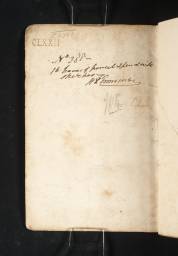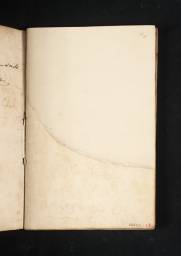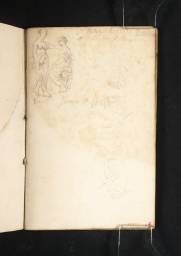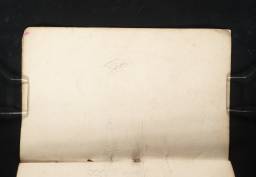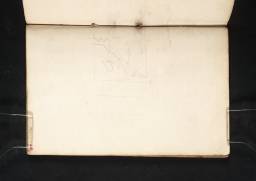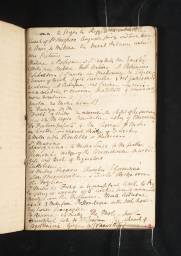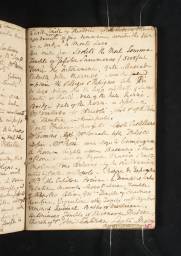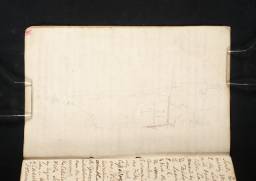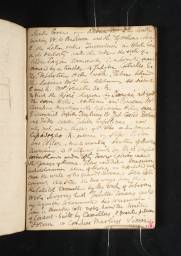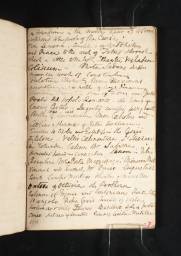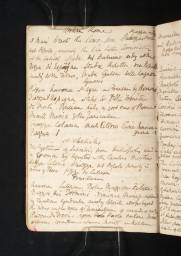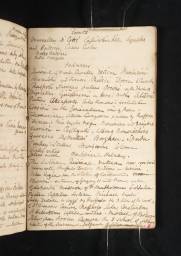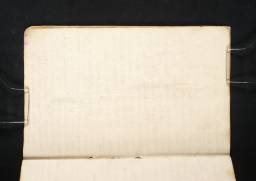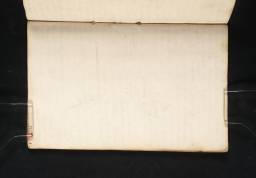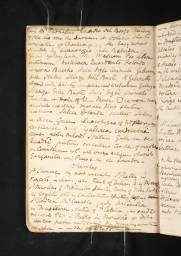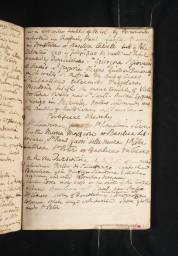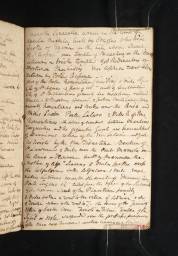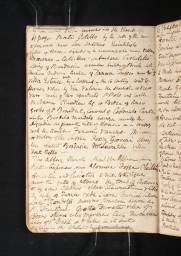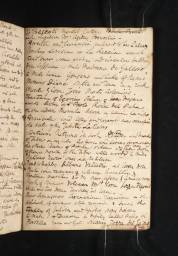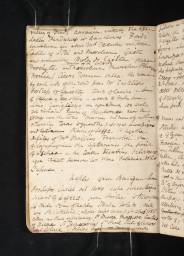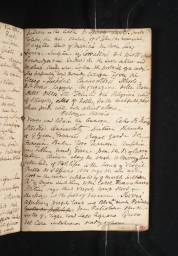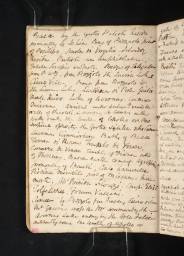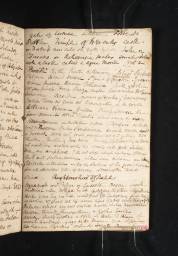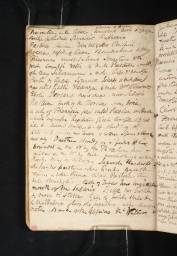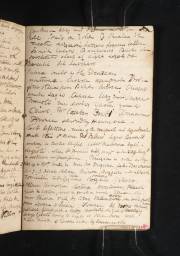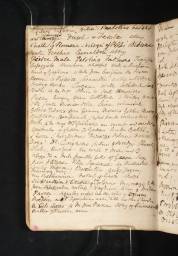Turner Bequest CLXXII
Notebook with thin marbled board covers
30 leaves of white wove paper, approximate page size 155 x 99 mm
Made by James Ansell, Carshalton Mill, Surrey; various pages watermarked ‘JA | 1811’ and ‘J’.
30 leaves of white wove paper, approximate page size 155 x 99 mm
Made by James Ansell, Carshalton Mill, Surrey; various pages watermarked ‘JA | 1811’ and ‘J’.
Inscribed by the artist in ink ‘98 Foreign Hint.’ on label on spine (D40677)
Stamped in black ‘CLXXII’ top right
Stamped in black ‘CLXXII’ top right
Inside front cover (D40678) is numbered ‘388’ as part of the Turner Schedule in 1854 and endorsed by the Executors of the Turner Bequest, inscribed in ink ‘16 leaves of pencil & pen and ink | sketches | H.S. Trimmer’ and initialled in pencil by Charles Lock Eastlake and John Prescott Knight, ‘C.L.E.’ and ‘J.P.K.’.
Inscribed by an unknown hand in pencil ‘CLXXII’ top left
Stamped in ink ‘CLXXII’ top left
Inscribed by an unknown hand in pencil ‘CLXXII’ top left
Stamped in ink ‘CLXXII’ top left
Accepted by the nation as part of the Turner Bequest 1856
Exhibition history
References
One of twenty-three sketchbooks related to Turner’s first Italian tour from August 1819 to January 1820. The book represents Turner’s mental preparations for his trip, containing twenty-two pages of notes condensed from John Chetwode Eustace’s A Tour Through Italy, first published in 1813, and later re-titled A Classical Tour Through Italy. There are also seven pages of small illustrations copied by Turner from Select Views in Italy, with Topographical and Historical Descriptions, in English and French by John ‘Warwick’ Smith, William Byrne and John Emes, first published in 1792–6. Visible watermarks in the paper date the sketchbook to 1811 but the chronology of Turner’s precise use of it remains unclear. It is probable that the notes and copies from A Classical Tour and the Select Views were made circa 1818–19, in preparation for the imminent trip. Additionally, interspersed throughout there are a few rough pencil sketches, some of which relate to Italian subjects, and others of landscapes and boats which probably predate the tour. John Ruskin described it on the wrapper as ‘388. The Roman Book. With minute sketches’ whilst Turner himself labelled it ‘Foreign Hint’.
Eustace’s A Classical Tour Through Italy, was one of the best known travel guidebooks of the early nineteenth century. According to the author in the ‘Preliminary Discourse’ of the publication: ‘The degree of preparation necessary for travelling depends upon the motives which induce us to travel’.1 The ‘loiterer’ who leaves home merely for novelty and amusement requires only ‘a convenient post-chaise, a letter of credit, and a well-furnished trunk’.2 By contrast, the intellectual reader ‘of a liberal and active mind’ is advised to prepare thoroughly.3 Eustace recommends a thorough grounding, not only in classical literature and poetry, the history of the country, architecture, sculpture and painting, and the Italian language, but also more esoteric branches of learning such as the study of antique medals. Whilst Turner had neither the time, nor the academic training to attempt to meet such ambitious expectations, he nevertheless seems to have taken Eustace’s general exhortation to heart and in this lightweight, pocket-sized notebook, he made notes from the four volumes of Eustace’s text in preparation for his first trip to Italy in 1819. The information which Turner chose to record is largely restricted to general travel instructions which he sifted out from the extensive moralising and intellectual arguments presented by the author. The majority of his notes are therefore comprised of factual details such as the distance between locations, lists of must-see sights and brief comments about historical background, all recorded in an informal, notational style unconcerned with grammar or punctuation. Turner seems to have conceived of the Italian Guide Book as a ‘vade mecum’, to be carried with him during his travels, and several pencil inscriptions concerning Italian subjects confirm his on-the-spot use of it during his tour of the country, see folios 2, 4, 18 verso, 28 verso, 29 verso and 30 verso (D13935, D13938, D13965, D13985, D13987, D13989). It is not know when the Eustace notes were made although it is reasonable to assume they were composed with an imminent trip in mind. The first edition of A Classical Tour was published in 1813 but Cecilia Powell has ascertained that details within Turner’s notes correspond with minor variations in the updated versions published in 1815 or 1817.4 It is the 1815 edition which is quoted here throughout.
It is likely that the route outlined by Eustace in A Classical Tour had a significant influence on the itinerary which Turner ultimately chose to follow. Both journeyed towards Rome via Verona and Venice although where Eustace travelled via the Austrian Alps, Bolsano and Trento, Turner’s approach came via France, Mont Cenis and Milan. His notes in the Italian Guide Book sketchbook appear to commence with the journey from Parma, see folio 4 (D13938), a city which he does not seem to have visited until the homeward section of his trip. However, Cecilia Powell has suggested that Turner may have studied the preceding part of the book which discusses the northern cities of Verona, Vicenza, Padua and Venice, but that for some reason these pages were removed from the notebook.5 From Bologna to Rome, Turner closely followed the same road as Eustace incorporating Ancona, Loretto, Macerata, the Apennine Mountains, Foligno, Spoleto, Terni, Narni, Civita Castellana and finally, the Eternal City itself. His notes from Eustace would therefore have been useful at every step of the journey, alerting him to the salient objects of attention in each new place. Turner extracted the greatest amount of information from the chapters concerning the ancient ruins, monuments, churches, villas and palaces of Rome, revealing that this was his principal focus for the trip. He also followed Eustace’s model for further travel beyond Rome, such as separate excursions to Tivoli and the Alban Hills, before proceeding south towards Naples via Terracina, Fondi and Pozzuoli, and onwards to Posillipo, Pompeii, Salerno and Paestum. Turner ignored much of Eustace’s account of the return trip to Rome but the notes pick up the thread again regarding the road from Rome to Florence.
The last portion of Turner’s text deals with Genoa, Milan, the Italian Lakes and an expedition to the Passage of the Simplon in the Alps and Turin, see folios 15 verso, 16 and 16 verso (D13960–D13962). These are also the hastiest and most summary sections of his notes, possibly because they were made before Turner had fixed his travel plans with any degree of certainty. Although he didn’t reach Genoa until his second trip in 1828, he did pass through Milan and Turin on the road home in 1819–20. However, he also seems to have visited the two cities on the outward passage, adapting Eustace’s circuit of Lakes Maggiore, Como and Lugarno before reaching Venice. Furthermore, Eustace’s description of the Alpine Pass of the Simplon may be accountable for Turner’s decision to make an unorthodox detour north-west from Lake Maggiore to Domodossola and Gondo, before recommencing the journey southwards towards Venice, a period of the trip which is recorded within the Turin, Como, Lugarno, Maggiore sketchbook (Tate; Turner Bequest CLXXIV) and Passage of the Simplon sketchbook (Tate; Turner Bequest CXCIV).6
The sketchbooks which Turner used during his first Italian tour demonstrate that he visited the vast majority of the sites and monuments listed within his notes. However, many of these landmarks and locations were of interest not simply because they were recommended by Eustace. They were part of a predetermined Grand Tour itinerary which was well established by the early nineteenth century. Many were also familiar artistic subjects in the vedute tradition, a standard repertory of topographical Italian views that had achieved an iconic status.7 Each location became associated with at least one major view so repeatedly executed from the same vantage point in paintings and prints that they became the visual counterpart of the traveller’s guidebook. This is evidenced by Turner’s sketches of landscapes after illustrations by John ‘Warwick’ Smith. A significant degree of overlap occurs between the subjects mentioned by Eustace, and those which appear as picturesque engravings in Select Views in Italy, with Topographical and Historical Descriptions, in English and French by John ‘Warwick’ Smith, William Byrne and John Emes, first published in 1792–6. On the pages following his written notes, Turner made small pen-and-ink copies of all but one of the seventy-two plates found within the publication. The only exception is plate no.22, titled Village near Castello Nuovo, see folio 19 verso (D13967). Turner has made notes from the text accompanying this image but there is no corresponding image, perhaps because the engraving was missing from the edition he consulted. Turner’s miniature reproductions lack detail and often omit the figurative elements of Smith’s staffage. Nevertheless they are clearly recognisable scenes which replicate the compositional essentials of the originals. On several occasions during his travels Turner adopted a similar viewpoint when standing in front of the same subject. Comparison of several of the copied views with his on-the-spot treatment of, for example, the Temple of Clitumnus (Turner Bequest CLXXVII 37a; Tate D14725), the Bridge of Augustus at Narni (Turner Bequest CLXXVII 62; Tate D14773), Borghetto and the Ponte Felice (Turner Bequest CLXXVII 73a–74; Tate D14798–D14799), the bridge near Civita Castellana (Turner Bequest CLXXVII 79; Tate D14807), Marino (Turner Bequest CLXXXII 28; Tate D15347), Ariccia (Turner Bequest CLXXXII 82a; Tate D15455) and Terracina (Turner Bequest CLXXXIV 22a; Tate D15600) reveals that he was often either unconsciously or deliberately recreating the same picturesque arrangement within his sketches.
Although Turner owned some contemporary guidebooks to Italy such as Henry Sass’s A Journey to Rome and Naples, 1818 and Reichard’s Itinerary of Italy, neither A Classical Tour Through Italy nor Select Views are to be found amongst the contents list of his library.8 Cecilia Powell has suggested therefore that his introduction to these books is likely to have originated from Sir Richard Colt Hoare (1758–1838),9 and James Hakewill (1778–1843).10 The former was an enthusiastic antiquarian historian and amateur artist who had been a patron of Turner’s since the 1790s. Turner owned a copy of Colt Hoare’s Hints to Travellers in Italy, 1815, a privately printed volume which may have been gifted to the artist by the author. The book is a modest endeavour designed to act as a supplement to Eustace’s Classical Tour and Colt Hoare may therefore have also been responsible for guiding Turner to the original text on which his own Hints is based, although, since Colt Hoare owned the first (1813) edition of A Classical Tour it cannot have been his copy from which Turner made the Italian Guide Book notes.11 The Hoare library did, however, also contain Select Views in Italy and Turner may have made his copies of the plates from this. Meanwhile, much of Turner’s immediate knowledge of planning and executing an Italian tour came from James Hakewill, a draughtsman and author of the topographical engraved series, A Picturesque Tour of Italy, published 1818–20. Turner provided several watercolour illustrations for this series based upon Hakewill’s own drawings and it may have been this sustained creative focus on Italy which ultimately prompted him to organise his own trip there. Hakewill wrote Turner copious instructions regarding itinerary and travelling tips in the Route to Rome sketchbook (Tate; Turner Bequest CLXXI). It is therefore plausible that he may also have lent him Eustace’s A Classical Tour, a book which Hakewill acknowledged had informed his own route in 1817 and which was much quoted in the letterpress of the Picturesque Tour of Italy.12
The book also contains a number of pencil sketches scattered throughout the pages. Some of these, such as the study of the statue commonly known as the ‘Pasquino’ or the sketches from the frescoes in the Villa Farnesina, can be directly related to the 1819 Italian tour and would have been drawn by Turner directly in front of the subject during his travels. There are however, also a number of landscape views and sketches of boats which interrupt the sequence of pages containing Turner’s writings, suggesting that they predate use of the sketchbook as a notebook. These sketches are largely unidentified but may be English subjects dating from 1811–19.
See Federico Crimi, ‘J.M.W. Turner e il Verbano. Sulle vedute del porto di Arona e dell’Isola Bella’ in Verbanus, vol.27, 2006, pp.177–202.
See for example Peter Galassi, Corot in Italy: Open-Air Painting and the Classical-Lanscape Tradition, New Haven and London 1991, p.85 and Malcolm Campbell, ‘The Vedute Tradition’ in Steven Brooke, Views of Rome, New York 2000, pp.20–3.
Turner’s library is retained in a private collection, see Andrew Wilton, Turner in his Time, London 1987, pp.246–7, and there are also some books, such as Reichard’s Italy, in the Turner Bequest (Tate).
Technical notes
How to cite
Nicola Moorby, ‘Italian GuideBook sketchbook c.1819’, sketchbook, July 2008, in David Blayney Brown (ed.), J.M.W. Turner: Sketchbooks, Drawings and Watercolours, Tate Research Publication, December 2012, https://www

